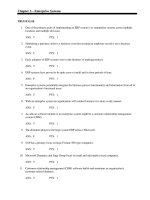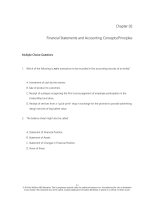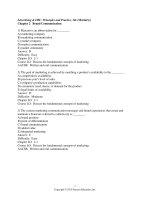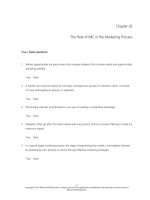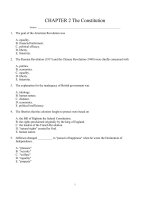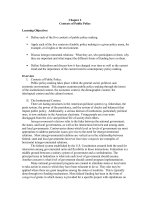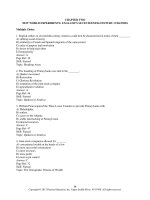College physics 10th edition young test bank
Bạn đang xem bản rút gọn của tài liệu. Xem và tải ngay bản đầy đủ của tài liệu tại đây (125.02 KB, 9 trang )
MULTIPLE CHOICE. Choose the one alternative that best completes the statement or answers the question.
1)
If the fastest you can safely drive is 65 mi/h, what is the longest time you can stop for
dinner if you must travel 487 mi in 9.8 h total?
A) 1.8 h
B) 2.3 h
C) 2.5 h
D) You can't stop at all.
1)
2)
A car accelerates from 5.0 m/s to 21 m/s at a rate of 3.0 m/s2. How far does it travel
while accelerating?
A) 207 m
B) 41 m
C) 69 m
D) 117 m
2)
3)
An airplane needs to reach a velocity of 203.0 km/h to take off. On a 2000 m runway,
what is the minimum acceleration necessary for the plane to take flight?
A) 1.0 m/s 2
B) 0.95 m/s2
C) 0.79 m/s 2
D) 0.87 m/s2
3)
4)
Assuming equal rates of acceleration in both cases, how much further would you travel
if braking from 56 mi/h to rest than from 28 mi/h.
A) 5.2 times farther
B) 4.8 times farther
C) 4 times farther
D) 3.2 times farther
4)
5)
Acceleration is sometimes expressed in multiples of g, where g = 9.8 m/s2 is the
acceleration due to the earth's gravity. In a car crash, the car's velocity may go from
30 m/s to 0 m/s in 0.15 s. How many g's are experienced, on average, by the driver?
A) 14 g
B) 24 g
C) 20 g
D) 26 g
5)
6)
A baseball is hit with a bat and, as a result, its direction is completely reversed and its
speed is doubled. If the actual contact with the bat lasts 0.45 s, what is the ratio of the
acceleration to the original velocity?
A) -2.2 s-1
B) -6.7 s-1
C) -0.15 s-1
D) -4.4 s-1
6)
1
Use Figure 2.1 to answer the following question(s).
Figure 2.1
7)
The graph in Figure 2.1 shows the position of an object as a function of time. The
letters H-L represent particular moments of time. At which moment in time is the speed
of the object the highest?
A) H
B) K
C) L
D) I
E) J
7)
8)
The graph in Figure 2.1 shows the position of an object as a function of time. The
letters H-L represent particular moments of time. At which moment in time is the speed
of the object equal to zero?
A) H
B) I
C) J
D) L
E) K
8)
9)
A train starts from rest and accelerates uniformly, until it has traveled 5.6 km and
acquired a velocity of 42 m/s. The train then moves at a constant velocity of 42 m/s for
420 s. The train then slows down uniformly at 0.065 m/s2, until it is brought to a halt.
9)
The acceleration during the first 5.6 km of travel is closest to:
A) 0.17 m/s2
B) 0.20 m/s2
0.14 m/s2
D) 0.16 m/s2
C)
E) 0.19 m/s2
10)
A train starts from rest and accelerates uniformly, until it has traveled 2.1 km and
acquired a velocity of 24 m/s. The train then moves at a constant velocity of 24 m/s for
400 s. The train then slows down uniformly at 0.065 m/s2, until it is brought to a halt.
The distance traveled by the train while slowing down, in km, is closest to:
A) 3.8
B) 3.6
C) 4.4
D) 4.0
2
E) 4.2
10)
11)
A car moving at a velocity of 20 m/s is behind a truck moving at a constant velocity of
18 m/s. When the car is 50 m behind the front of the truck, the car accelerates uniformly
at 1.8 m/s2. The car continues at the same acceleration until it reaches a velocity of
11)
25 m/s, which is the legal speed limit. The car then continues at a constant velocity of
25 m/s, until it passes the front of the truck. The distance the car travels while
accelerating, in meters, is closest to:
A) 58
B) 62
C) 66
D) 54
E) 50
12)
A motorist makes a trip of 180 miles. For the first 90 miles she drives at a constant
speed of 30 mph. At what constant speed must she drive the remaining distance if her
average speed for the total trip is to be 40 mph?
A) 45 mph
B) 60 mph
C) 55 mph
D) 50 mph
E) 52.5
mph
12)
13)
A racquetball strikes a wall with a speed of 30 m/s and rebounds with a speed of 26 m/s.
The collision takes 20 ms. What is the average acceleration of the ball during the
collision?
A) zero
B) 200 m/s2
C) 1500 m/s2
13)
1300 m/s2
E) 2800 m/s2
D)
14)
Which of the following situations is impossible?
A) An object has velocity directed east and acceleration directed east.
B) An object has zero velocity but non-zero acceleration.
C) An object has constant non-zero acceleration and changing velocity.
D) An object has constant non-zero velocity and changing acceleration.
E) An object has velocity directed east and acceleration directed west.
3
14)
15)
A racing car accelerates uniformly from rest along a straight track. This track has
markers spaced at equal distances along it from the start, as shown in Figure 2.2. The
car reaches a speed of 140 km/h as it passes marker 2.
15)
Figure 2.2
Whereabouts on the track was the car when it was travelling at half this speed, i.e. at 70
km/h?
A) Before marker 1
B) Between marker 1 and marker 2
C) At marker 1
16)
A stone is thrown vertically upwards, reaches a highest point, and returns to the ground.
When the stone is at the top of its path, its acceleration
A) is zero.
B) is directed upwards.
C) changes direction from upwards to downwards.
D) is directed downwards.
4
16)
17)
The motions of a car and a truck along a straight road are represented by the
velocity-time graphs in Figure 2.3. The two vehicles are initially alongside each other at
time t = 0.
17)
Figure 2.3
At time T, what is true of the distances travelled by the vehicles since time t = 0?
A) The truck will have travelled further than the car.
B) The truck will not have moved.
C) The car will have travelled further than the truck.
D) They will have travelled the same distance.
18)
Two identical objects A and B fall from rest from different heights to the ground. If
object B takes twice as long as A to reach the ground, what is the ratio of the heights
from which A and B fell? Neglect air resistance.
A) 1 : 4
B) 1 : 2
C) 1 : 2
D) 1 : 8
18)
19)
A ball is projected upward at time t = 0.0 s, from a point on a roof 60 m above the
ground. The ball rises, then falls and strikes the ground. The initial velocity of the ball is
28.4 m/s. Consider all quantities as positive in the upward direction. At time t = 4.3 s,
the acceleration of the ball is closest to:
A) -10 m/
B) -5 m/s2
C) +5 m/s2
D) zero
E) +10 m/
s2
s2
19)
20)
A ball is projected upward at time t = 0.0 s, from a point on a roof 10 m above the
ground. The ball rises, then falls and strikes the ground. The initial velocity of the ball is
58.5 m/s. Consider all quantities as positive in the upward direction. At time t = 5.97 s,
the velocity of the ball is closest to:
A) -175
B) zero
C) -12 m/s
D) +175
E) +12 m/s
m/s
m/s
20)
5
21)
A ball is projected upward at time t = 0.0 s, from a point on a roof 90 m above the
ground. The ball rises, then falls and strikes the ground. The initial velocity of the ball is
80.5 m/s. Consider all quantities as positive in the upward direction. The velocity of the
ball when it is 89 m above the ground is closest to:
A) -48 m/s
B) -81 m/s
C) -97 m/s
D) -64 m/s
E) -32 m/s
21)
22)
A test rocket is fired straight up from rest with a net acceleration of 20 m/s2. After 4
seconds the motor turns off, but the rocket continues to coast upward. What maximum
elevation does the rocket reach?
A) 408 m
B) 487 m
C) 160 m
D) 327 m
E) 320 m
22)
23)
A child standing on a bridge throws a rock straight down. The rock leaves the child's
hand at t = 0. Which of the graphs shown here best represents the velocity of the stone
as a function of time?
23)
A)
B)
C)
D)
E)
6
24)
A toy rocket is launched vertically from ground level (y = 0 m), at time t = 0.0 s. The
rocket engine provides constant upward acceleration during the burn phase. At the
instant of engine burnout, the rocket has risen to 64 m and acquired a velocity of
60 m/s. The rocket continues to rise in unpowered flight, reaches maximum height, and
falls back to the ground. The time interval, during which the rocket engine provides
upward acceleration, is closest to:
A) 1.9 s
B) 1.5 s
C) 2.3 s
D) 2.1 s
E) 1.7 s
24)
25)
A toy rocket is launched vertically from ground level (y = 0 m), at time t = 0.0 s. The
rocket engine provides constant upward acceleration during the burn phase. At the
instant of engine burnout, the rocket has risen to 81 m and acquired a velocity of
40 m/s. The rocket continues to rise in unpowered flight, reaches maximum height, and
falls back to the ground. The upward acceleration of the rocket during the burn phase is
closest to:
A) 9.6 m/
B) 9.0 m/
C) 8.7 m/
D) 9.9 m/
E) 9.3 m/
s2
s2
s2
s2
s2
25)
26)
A toy rocket is launched vertically from ground level (y = 0 m), at time t = 0.0 s. The
rocket engine provides constant upward acceleration during the burn phase. At the
instant of engine burnout, the rocket has risen to 49 m and acquired a velocity of
60 m/s. The rocket continues to rise in unpowered flight, reaches maximum height, and
falls back to the ground. The maximum height reached by the rocket is closest to:
A) 233 m
B) 221 m
C) 244 m
D) 256 m
E) 209 m
26)
Situation 2.1
A rock is projected upward from the surface of the moon, at time t = 0.0 s, with a velocity of 30 m/s. The
acceleration due to gravity at the surface of the moon is 1.62 m/s2.
27)
In Situation 2.1, the time when the rock is ascending and at a height of 180 m is closest
to:
A) 17 s
B) 30 s
C) 12 s
D) 23 s
E) 8 s
27)
28)
In Situation 2.1, the height of the rock when it is descending with a velocity of 20 m/s is
closest to:
A) 125 m
B) 115 m
C) 135 m
D) 145 m
E) 155 m
28)
29)
A ball is thrown straight upward with a velocity of 18 m/s. How much time passes
before the ball strikes the ground? Disregard air resistance.
A) 1.8 s
B) 3.7 s
C) 0.6 s
D) 1.1 s
29)
7
30)
An object is dropped from rest into a pit, and accelerates due to gravity at roughly 10
m/s2. It hits the ground in 5 seconds. A rock is then dropped from rest into a second
pit, and hits the ground in 10 seconds. How much deeper is the second pit, compared to
the first pit? Neglect air resistance.
A) five times deeper
B) three times deeper
C) four times deeper
D) two times deeper
SHORT ANSWER. Write the word or phrase that best completes each statement or answers the question.
31)
A soccer ball is released from rest at the top of a grassy incline. After 6.4
seconds, the ball travels 91 meters. One second later, the ball reaches the bottom
of the incline.
a) What was the ball's acceleration? (Assume that the acceleration was
constant.)
b) How long was the incline?
31)
32)
A rock is thrown directly upward from the edge of the roof of a building that is
56.3 meters tall. The rock misses the building on its way down, and is observed
to strike the ground 4.00 seconds after being thrown. Take the acceleration due
to gravity to have magnitude 9.80 m/s2 and neglect any effects of air resistance.
With what speed was the rock thrown?
32)
33)
A package is dropped from a helicopter moving upward at 15 m/s. If it takes
18.0 s before the package strikes the ground, how high above the ground was
the package when it was released? Neglect air resistance.
33)
34)
At the same moment, one rock is dropped and one is thrown downward with an
initial velocity of 29 m/s from the top of a 300 m building. How much earlier
does the thrown rock strike the ground? Neglect air resistance.
34)
35)
Human reaction times are worsened by alcohol. How much further (in feet)
would a drunk driver's car travel before he hits the brakes than a sober driver's
car? Assume that both are initially traveling at 50.0 mph and their cars have the
same acceleration while slowing down, and that the sober driver takes 0.33 s to
hit the brakes in a crisis, while the drunk driver takes 1.0 s to do so.
35)
8
30)
Answer Key
Testname: UNTITLED2
1)
2)
3)
4)
5)
6)
7)
8)
9)
10)
11)
12)
13)
14)
15)
16)
17)
18)
19)
20)
21)
22)
23)
24)
25)
26)
27)
28)
29)
30)
B
C
C
C
C
B
E
B
D
C
B
B
E
D
A
D
A
A
A
B
B
B
E
D
D
A
E
E
B
C
a) 4.4 m/s2
b) 120 m
32) 5.53 m/s
33) 1300 m
34) 2.4 s
35) 49 ft
31)
9
